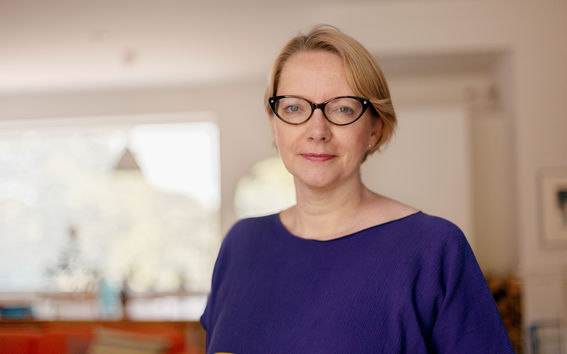'We must look to the past, for a lesson in designing buildings for the future'

The term 'sustainability' has become a mantra of modern times; a goal to guide our thinking through an age of warming temperatures, increasing pollution, and rising population growth. When applying the term to the design of the buildings in which we live and work, we tend to think of sustainability as being about clever systems for using solar energy, or for minimizing the use of water. These things are important, but there is another way too that we can make buildings sustainable: by designing them to last for hundreds of years.
Architect and Professor of Urban Design Practises, Karin Krokfors, says that in Finland and elsewhere it's not untypical for buildings to be demolished after just a few decades.
'A study conducted in 2016 by Satu Huuhka and Jukka Lahdensivu saw that many buildings were taken down after only 40 to 50 years,' she says. 'This isn't always because of their technical quality, but partly because they can't be adapted to any other kind of usage than what they were originally designed for.'
The buildings taken down are typically those in which room configurations and structures cannot easily be changed. Student housing often provides a good example of this. The way students want to arrange their living space may change in rapid cycles, while the areas in which student housing is built may fall out of favour.
Times change, but if the buildings cannot be changed – they are ripped down.
Making the same mistake
Krokfors draws a parallel between the current short-term focus in building design and the ethos that led to the creation of suburbs in the post-war era. She says that when making a design decision about the buildings in which people live and work, it's important to look at the whole picture – including any knock-on effects.
'I'm concerned we're making a similar mistake now as we did when we created suburbs,' says Krokfors. 'Many urban areas are still built mainly for residential use, with housing solutions that do not even meet existing needs, let alone tackle our unpredictable future needs.'
Krokfors points out that suburbs are often detached from service hubs, which puts pressure on transport services. There are also few spaces for people to meet and interact, which leads to social fragmentation, and small businesses are replaced by conglomerates in malls.
'Today, as people are pulled out of rural settings and small towns into bigger cities, we're still following this same functionalist ideology that drives us to build quickly without thinking about the long term,' she says. 'We're following an outmoded paradigm, even though we have a lot of evidence that it doesn't work.'
'When you build everything based on a single idea, then when you make a mistake – you make a very big mistake.'
Architect Karin KrokforsWe're following an outmoded paradigm, even though we have a lot of evidence that it doesn't work.”
Looking back, to look forward
Krokfors says that the answer is to design flexibility into buildings from the outset. For an example of success in this regard, she looks to the old merchant houses of Amsterdam (some of which date from the 17th century), the Victorian town houses of London, and even the apartments in older parts of Helsinki.
From an architectural perspective, the spatial configuration of Amsterdam's merchant houses is well designed. Their inner passage feeds easily into different parts of the building, and room spaces are big enough to be multi-usable and dividable. The houses are also adaptable both vertically and horizontally, which has led to them being converted into hotels, offices, family dwellings, and single-room apartments. Victorian town houses in the United Kingdom offer similar flexibility.
'We need to design building typology that promotes this kind of multi-usability, and that inspires us mentally as these buildings have done over the years,' says Krokfors. 'In Helsinki too, some of the buildings are more than 100 years old, with qualities that are still inspiring people today. They are beautiful and flexible, often because the dwellings have two entrances so you can easily divide and combine them into different sizes as needs change. There are also plenty of services nearby.'
'I'm not advocating a return to the form and function of the past, but I think we need to talk more about the quality of the built environment. We need to bring back that feeling of inspiration, and offer people buildings that can be adapted easily over time to meet our changing needs.'
Putting people first
Krokfors says that people's well-being and actual needs often take a back seat in building esign, whereas they should be at the core. With more and more people working from home, and older people living in their homes for longer, she believes buildings should be designed to accommodate the flexibility that people require in their lives, while also giving them the opportunity to interact with others.
'Promoting health and well-being is a big topic in urban design at the moment,' says Krokfors. 'The more we promote the well-being of people, the better societies we have. Inclusiveness has a big role to play here; people want to feel that they're part of something, and the way we design buildings needs to promote this sense of togetherness.'
'It's very hard to predict how our building needs will change over the next 50 years or 100 years,' she says. 'So we should not get attached to a single idea that may not work in the future; we need an ecosystem of several kinds of approaches. If we pilot different ways of doing things, then something may emerge that works for the longer term.'
'We need to encourage the self-organizing potential that we see in nature, and we should understand buildings as evolving organisms, so that people can organize their space in different ways for different aspirations.'
***
Finland presents its exhibition Everyday Experiments at the XXII Triennale di Milano, featuring twelve experimental projects people are already doing to make their lives more sustainable and equitable. La Triennale di Milano will take place from 1 March to 1 September 2019 and is curated by Paola Antonelli, Senior Curator of Architecture and Design and Director of Research & Development at The Museum of Modern Art. Broken Nature will reflect on the relationship between humans and environments at all scales—from the microbiome to the cosmos—including social, cultural, and natural ecosystems.
Learn more about all 12 Everyday Experiments: everdayexperiments.aalto.fi
The XXII Triennale, Broken Nature: http://www.brokennature.org/
Read more news

Your voice gives away valuable personal information, so how do you keep that data safe?
With speech technologies becoming increasingly common, researchers want to make sure we don’t give away more information than we mean to.
Aalto in 2025: Quantum leaps, creative breakthroughs and solutions for a better life
Growth, technology and industrial renewal; human-centred solutions; health and everyday wellbeing; and enjoyable daily life and thriving communities.
Research Council of Finland establishes a Center of Excellence in Quantum Materials
The Centre, called QMAT, creates new materials to power the quantum technology of coming decades.






